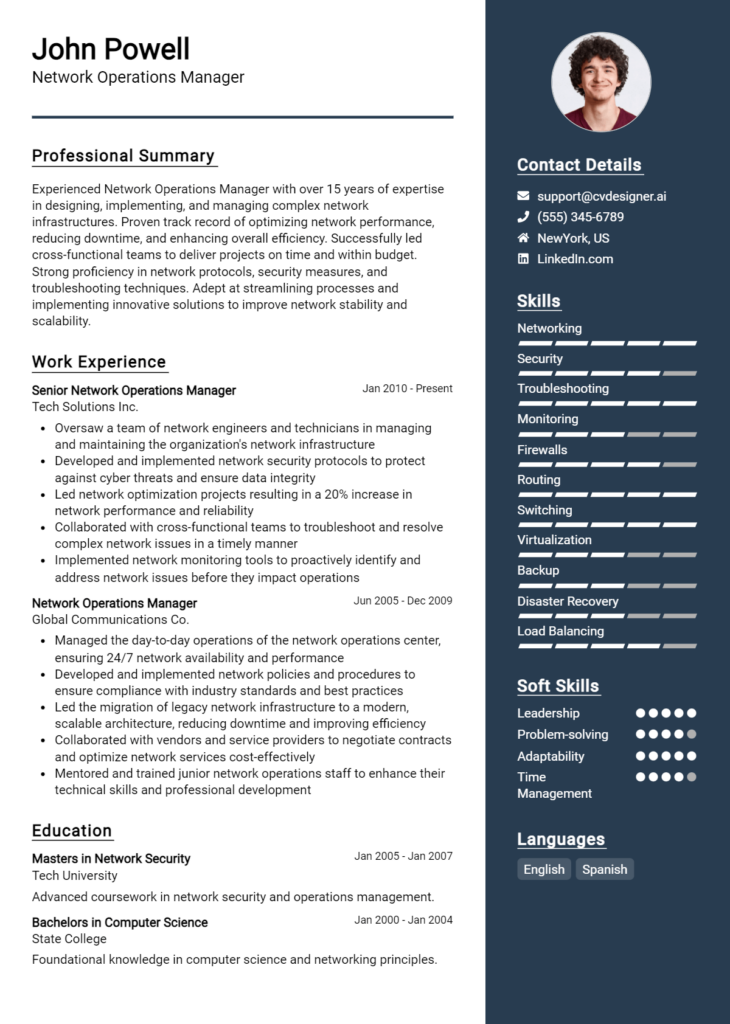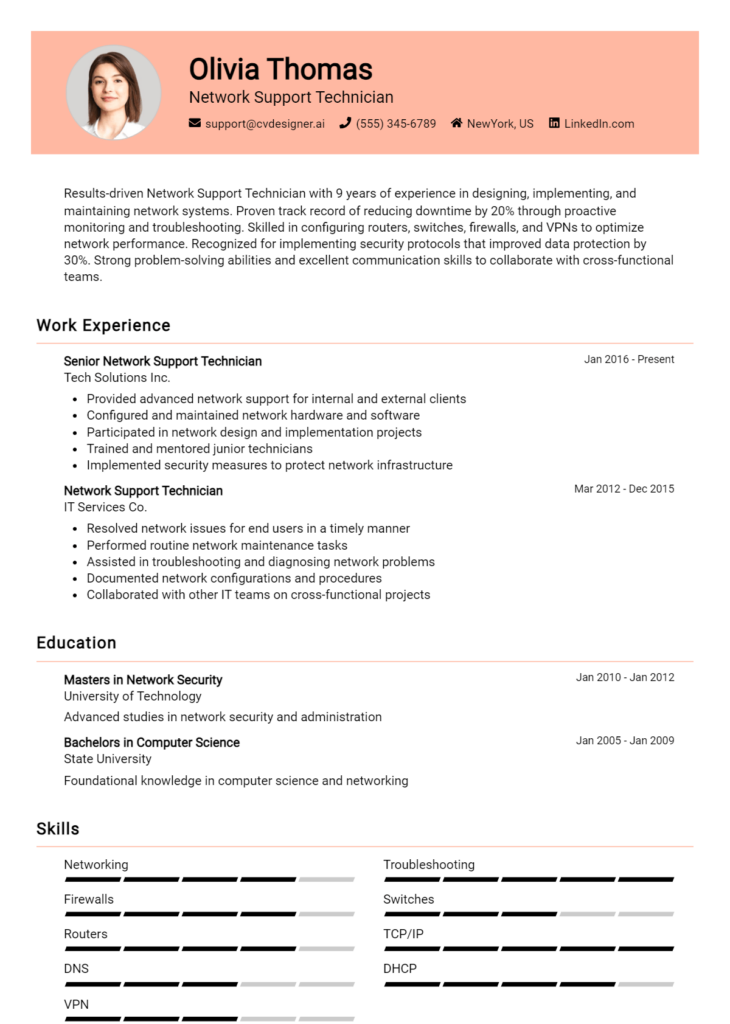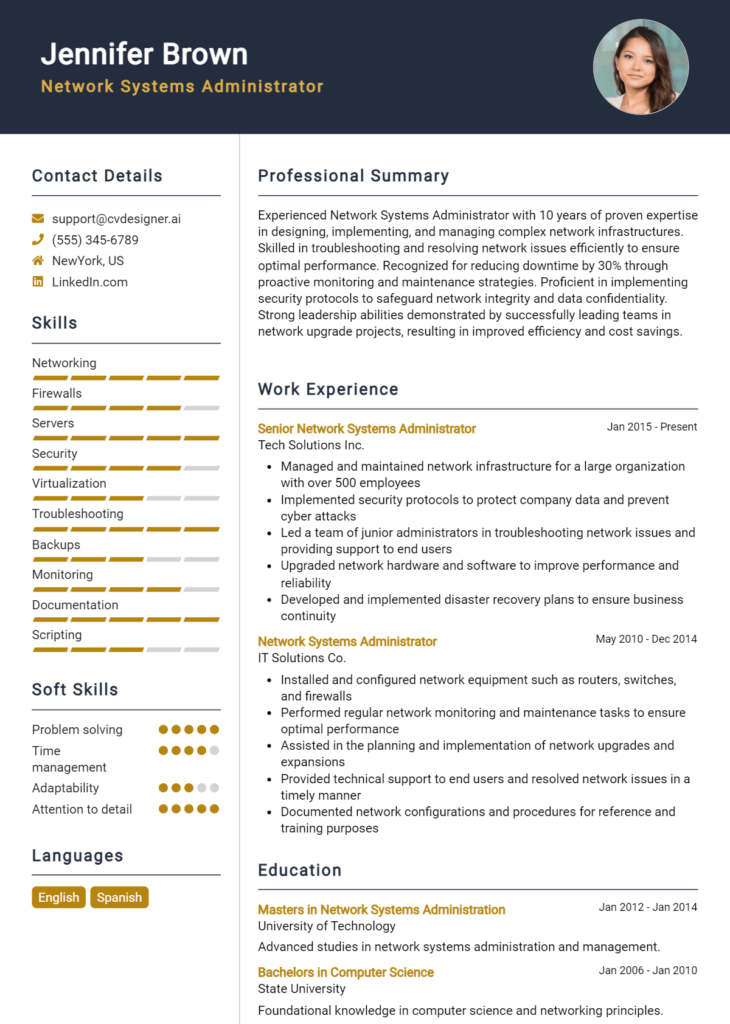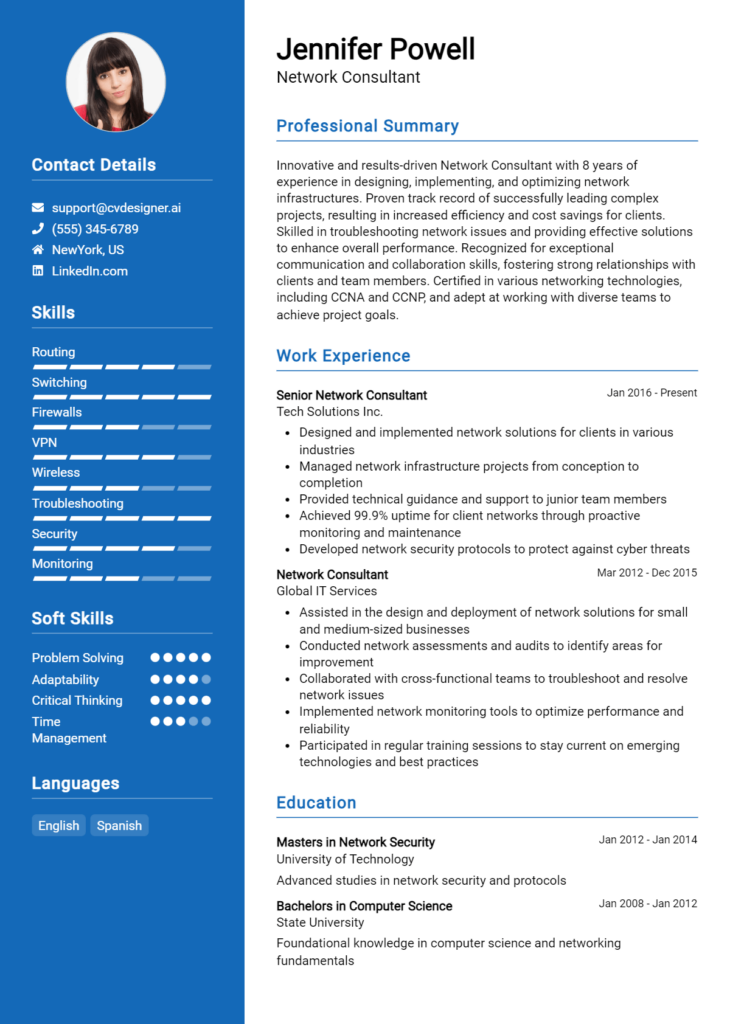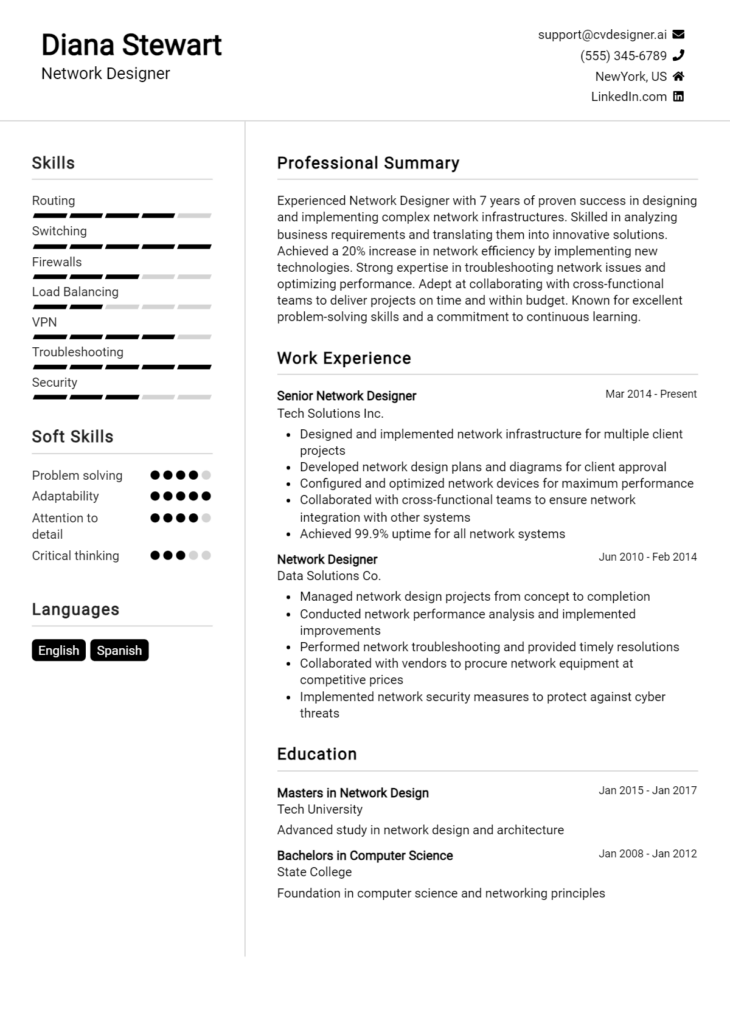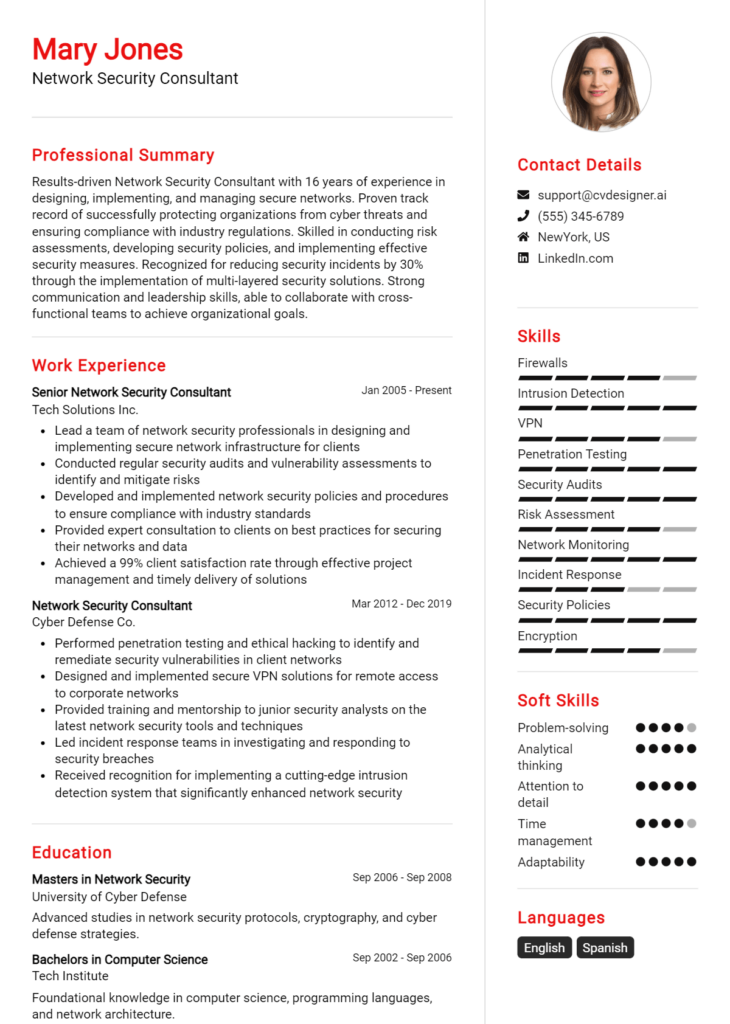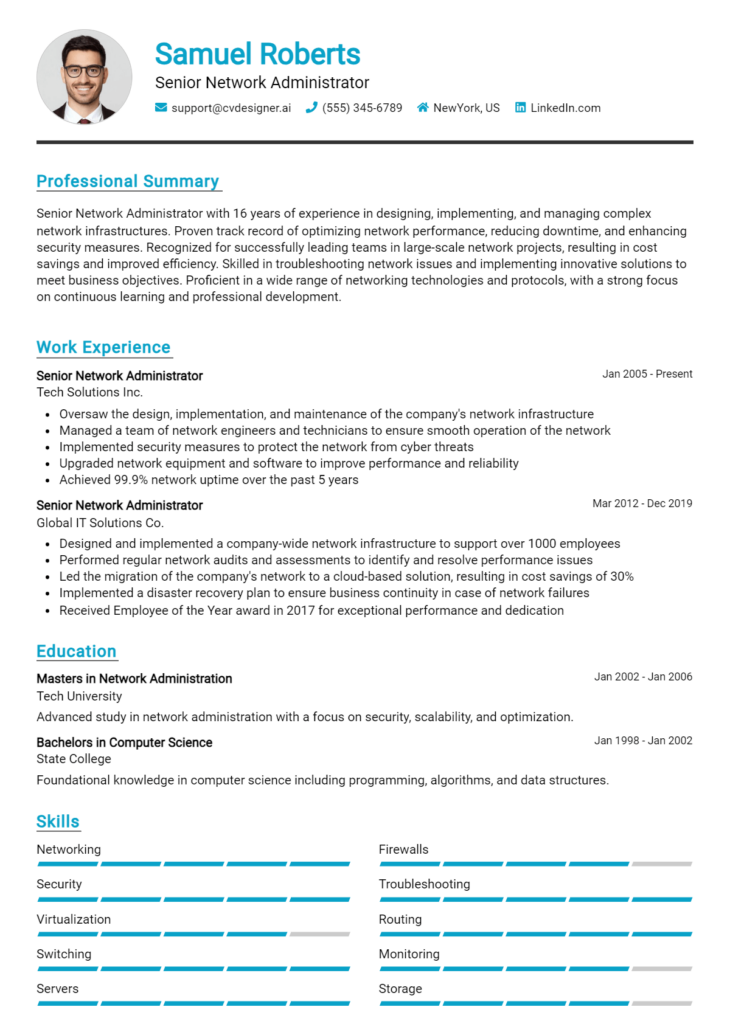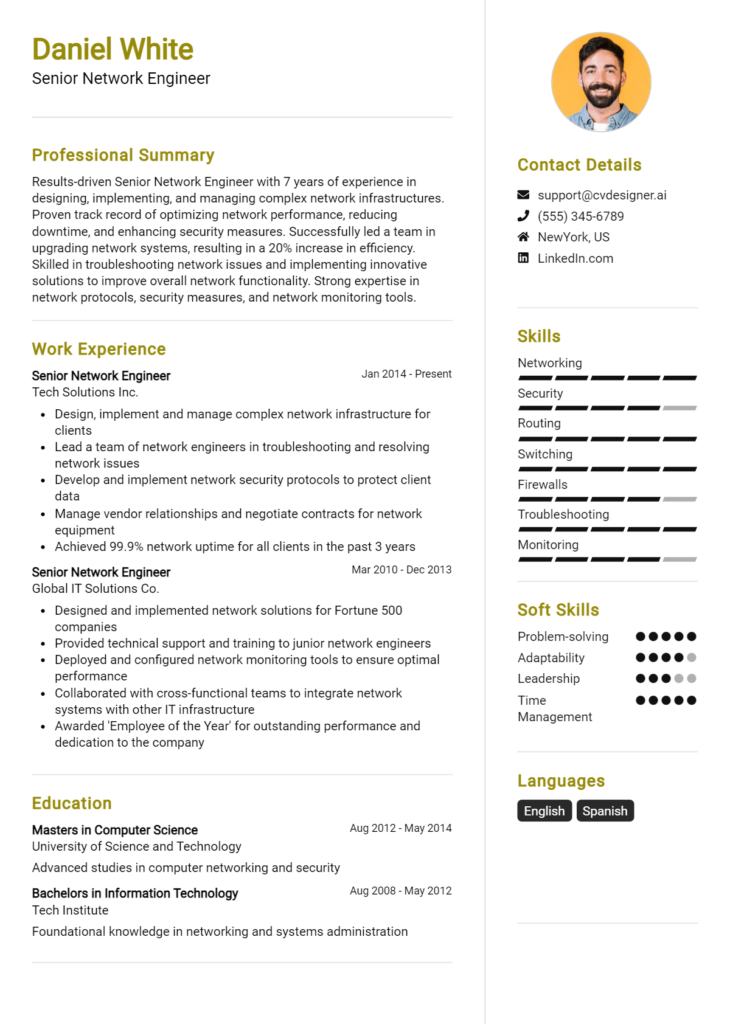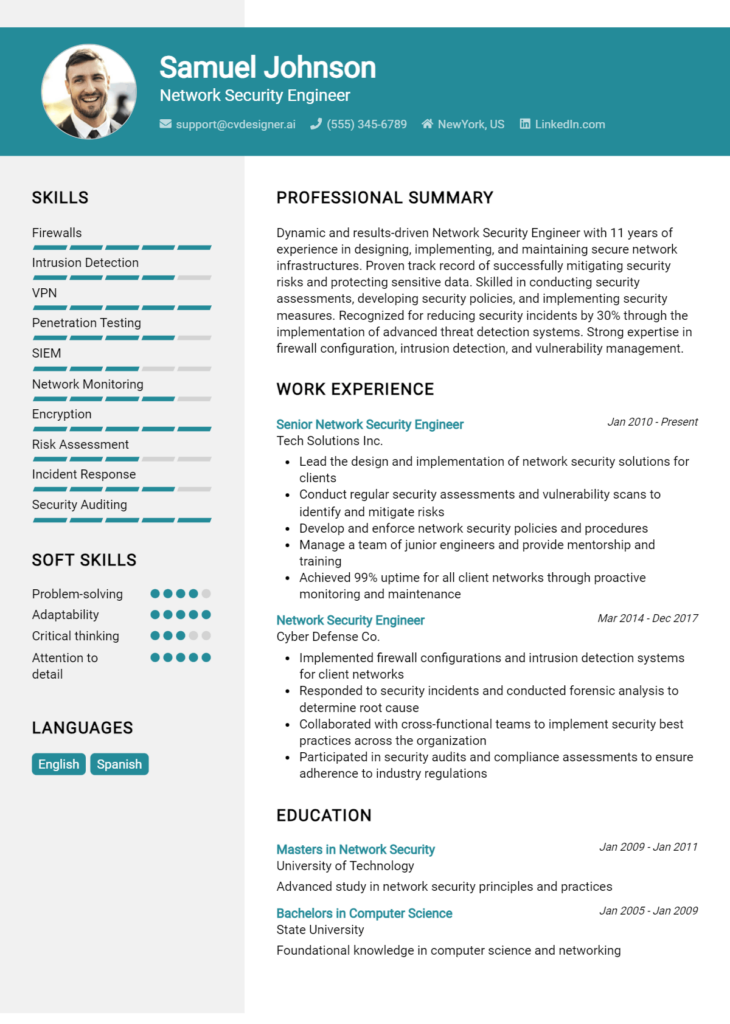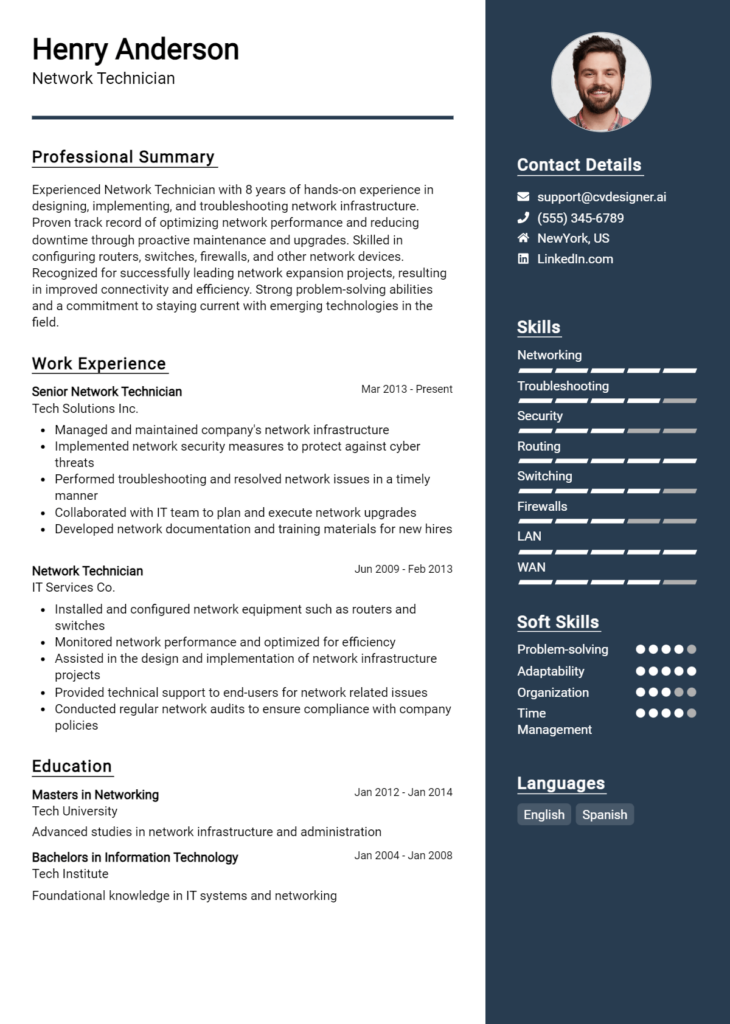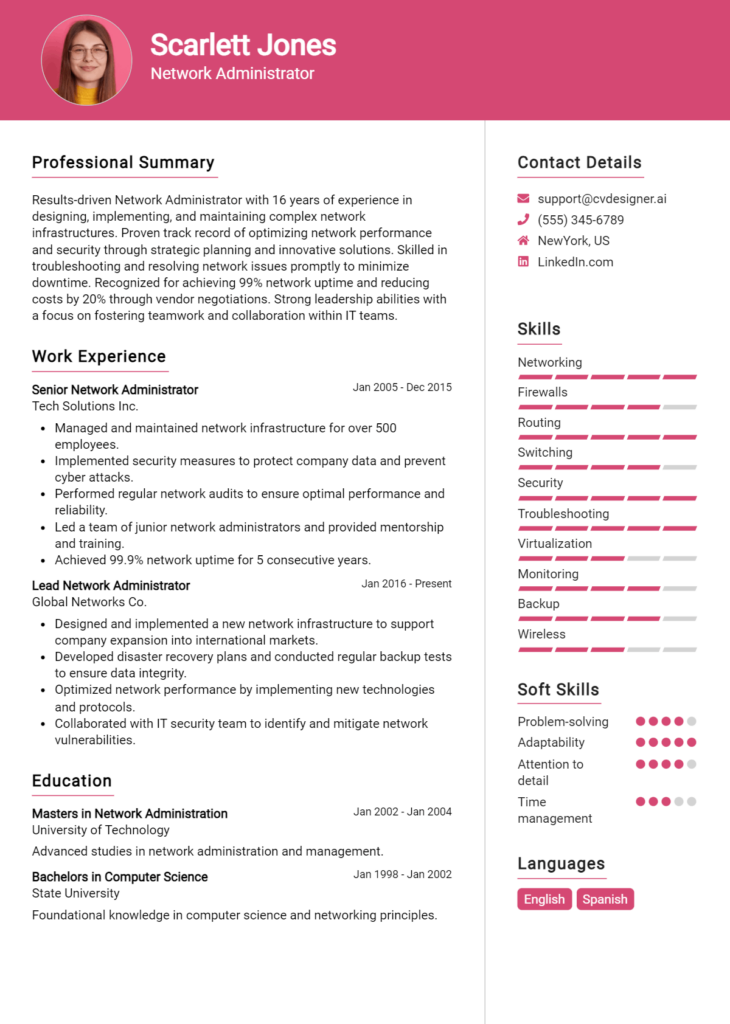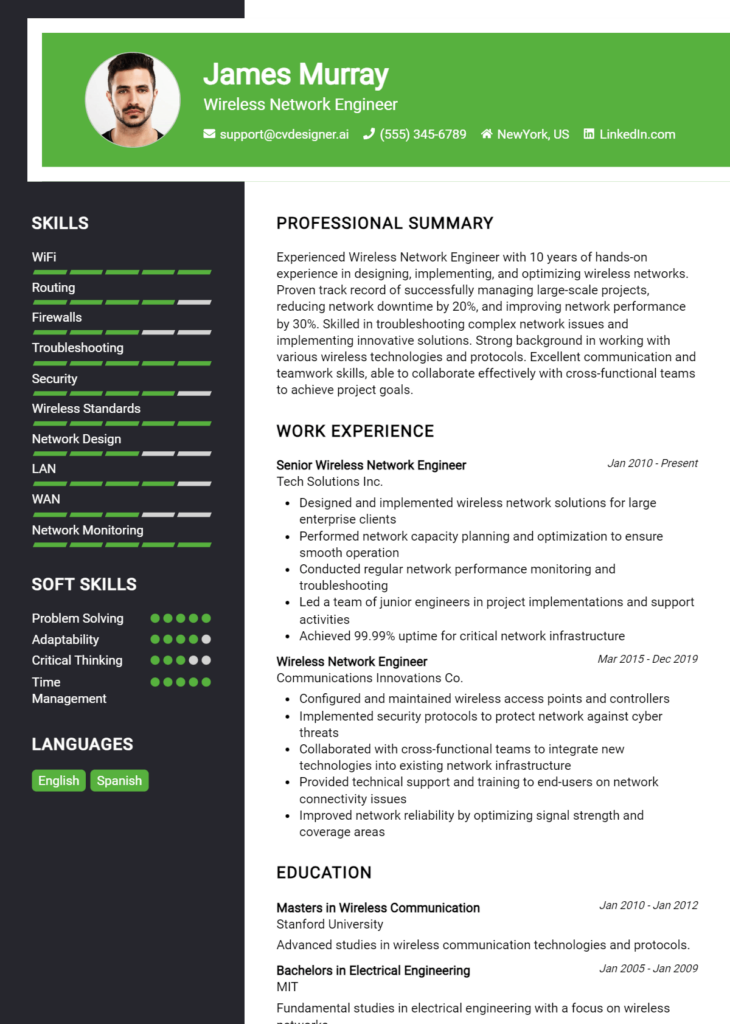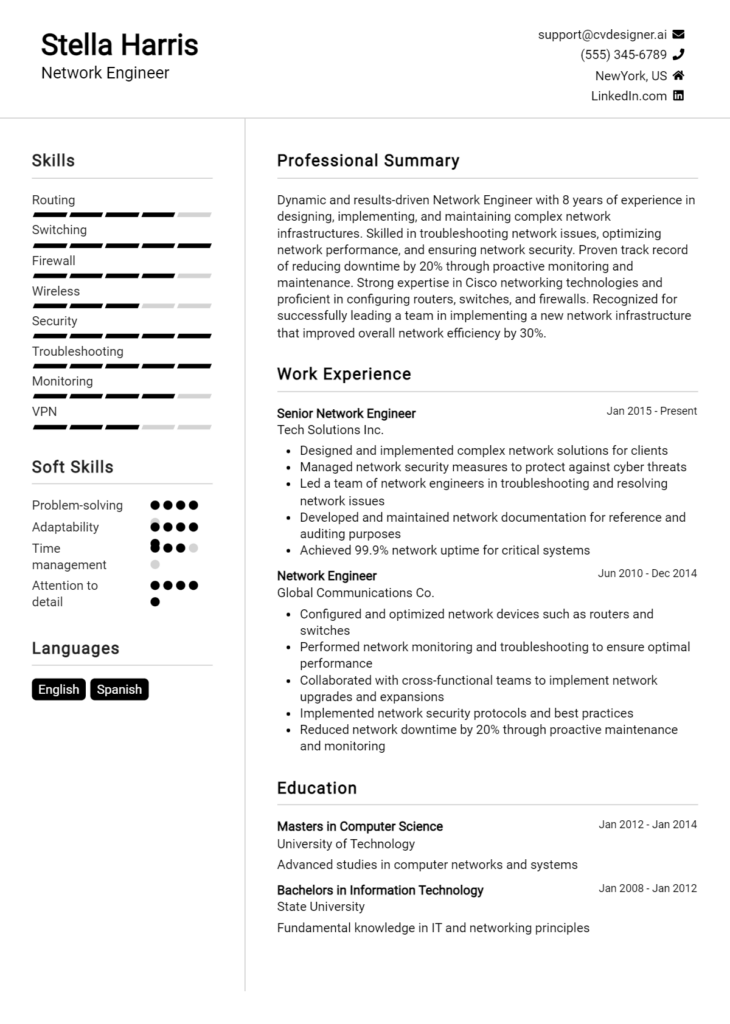Most Popular Network Support Engineer Resume Examples
Explore additional Network Support Engineer resume samples and guides and see what works for your level of experience or role.
As the digital landscape continues to evolve, the role of a Network Support Engineer has become increasingly vital in ensuring seamless connectivity and robust IT infrastructure. These professionals are the backbone of every organization’s network, troubleshooting issues, optimizing performance, and implementing security protocols. Crafting a compelling resume is essential for standing out in a competitive job market, as it showcases not only your technical expertise but also your problem-solving abilities and attention to detail. A well-structured resume can be the key to unlocking interviews and advancing your career in this dynamic field.
In this comprehensive guide, we will delve into the critical elements of writing an effective resume for a Network Support Engineer. You'll learn about the key responsibilities and skills that employers are looking for, how to choose the best format that highlights your strengths, and the common mistakes to steer clear of when crafting your resume. We’ll provide tailored resume examples for various experience levels, offer invaluable tips on resume writing, and help you select the right resume templates to enhance your presentation. With the right tools and insights, you'll be well-equipped to create a standout resume that captures the attention of hiring managers and secures your next opportunity in the exciting world of network support.
Key Responsibilities and Skills for a Network Support Engineer
As a Network Support Engineer, you play a crucial role in maintaining and optimizing an organization's network infrastructure. Your key responsibilities typically include:
- Troubleshooting Network Issues: Quickly identifying and resolving connectivity problems to ensure minimal downtime.
- Network Monitoring: Utilizing tools to monitor network performance and security, proactively addressing potential issues.
- Configuration Management: Setting up and configuring network devices such as routers, switches, and firewalls.
- Documentation: Maintaining detailed records of network configurations, changes, and incidents for future reference and compliance.
- User Support: Providing technical support to end-users, guiding them through network-related problems and ensuring a smooth user experience.
- Collaboration: Working with IT teams to implement network upgrades and improvements in line with organizational goals.
To excel in this role, a Network Support Engineer should possess the following essential skills:
- Proficiency in networking protocols (TCP/IP, DNS, DHCP, etc.)
- Experience with network monitoring and management tools
- Knowledge of firewall and security configurations
- Strong troubleshooting and problem-solving abilities
- Excellent communication and interpersonal skills
- Ability to work in a fast-paced and dynamic environment
Highlighting these skills effectively in the resume skills section is essential, as it allows potential employers to quickly assess your qualifications. Tailor these responsibilities and skills to align with the specific job description to stand out in a competitive job market. Additionally, consider how these skills could be relevant in creating a strong CV that showcases your expertise and experience, making you a compelling candidate for the position.
Best Resume Format and Structure for a Network Support Engineer
When crafting a resume for a Network Support Engineer position, selecting the right format is crucial to effectively showcase your skills and experience. Below is a detailed guide on the best resume structure tailored for this role.
Contact Information
Your resume should begin with your contact details, clearly positioned at the top. This section should include:
- Full Name
- Phone Number
- Professional Email Address
- LinkedIn Profile (optional but recommended)
- Location (City, State)
Professional Summary
A concise professional summary serves as your elevator pitch. This section should highlight your years of experience, key skills, and what you bring to the table. Aim for 2-4 sentences that summarize your background and achievements. For example:
- "Detail-oriented Network Support Engineer with over 5 years of experience in troubleshooting and maintaining network infrastructures. Proven expertise in LAN/WAN configurations, network security protocols, and performance optimization."
Work Experience
This section should detail your professional history, showcasing relevant roles and responsibilities. Use reverse chronological order, starting with your most recent position. For each job, include:
- Job Title
- Company Name
- Location (City, State)
- Dates of Employment (Month/Year – Month/Year)
- Bullet points outlining your achievements and responsibilities, focusing on quantifiable results and specific technologies used. For example:
- "Managed a team of 4 engineers in the deployment of a new VoIP system, resulting in a 30% increase in communication efficiency."
- "Resolved over 200 support tickets per month, maintaining a 95% customer satisfaction rate."
Education
Include your educational background, starting with the most recent degree. This section should feature:
- Degree (e.g., Bachelor of Science in Computer Science)
- University Name
- Location (City, State)
- Graduation Date (Month/Year)
If you have relevant coursework or projects, you can add them as bullet points under your degree.
Skills
List technical and soft skills that are pertinent to a Network Support Engineer role. Organize them into categories for clarity. Examples might include:
- Technical Skills: Network Configuration, Troubleshooting, TCP/IP, VPNs, Firewalls, Cisco Routers, Wireless Technologies
- Soft Skills: Problem-Solving, Communication, Team Collaboration, Time Management
Certifications
Highlight any relevant certifications that enhance your qualifications. This section should include the certification title, the issuing organization, and the date obtained. Notable certifications for a Network Support Engineer may include:
- Cisco Certified Network Associate (CCNA)
- CompTIA Network+
- Microsoft Certified: Azure Network Engineer Associate
Tips for Formatting Your Resume
- Choose a Clean Layout: Use a professional font (e.g., Arial, Calibri) and maintain a font size between 10-12 points. Ensure there is ample white space to make the document easy to read.
- Use Bullet Points: They help in breaking down information and make it easier for hiring managers to scan through your experience and skills.
- Consistency is Key: Keep formatting consistent throughout the document, such as the use of bold for headings and uniform bullet point styles.
- Tailor Your Resume: Customize your resume for each job application, ensuring that you highlight the most relevant experience and skills for the specific position you are applying for.
Complementing Your Resume with a Cover Letter
The format of your resume should be cohesive with your cover letter. Use the same font, color scheme, and header style to create a professional and unified package. Your cover letter should reiterate key qualifications mentioned in your resume while providing more context about your experiences and showcasing your enthusiasm for the role. This alignment helps to reinforce your brand and makes a strong impression on potential employers.
By following this structured approach, you can create a compelling resume that effectively highlights your qualifications as a Network Support Engineer and enhances your chances of landing an interview.
Writing Tips and Best Practices for a Network Support Engineer Resume
When crafting a resume as a Network Support Engineer, it's essential to present your skills and experiences clearly and effectively to capture the attention of hiring managers. Start with a concise summary that highlights your technical abilities and relevant experience in networking technologies. Utilize action verbs to convey your achievements and responsibilities dynamically, and make sure to quantify your accomplishments—such as reduced downtime by a specific percentage or successfully managing a defined number of network devices—whenever possible. Incorporate industry-specific keywords that align with the job description to enhance your chances of passing Applicant Tracking Systems (ATS). Additionally, ensure your resume maintains a professional appearance by following resume writing tips and consider how similar practices apply when drafting your cover letter.
- Begin with a strong summary statement that encapsulates your experience and expertise in network support.
- Use action verbs like "configured," "troubleshot," "implemented," and "monitored" to begin bullet points, making your contributions clear and impactful.
- Quantify your achievements by providing specific metrics, such as the number of networks supported or issues resolved within a timeframe.
- Highlight relevant certifications (e.g., CCNA, CompTIA Network+) to demonstrate your qualifications and commitment to professional development.
- Tailor your resume for each application by including keywords from the job description, ensuring alignment with the employer's needs.
- Organize your resume with clear headings and bullet points for easy readability, making it simple for hiring managers to scan for relevant information.
- Include a section for technical skills, listing networking tools and software you are proficient in, such as Cisco, Juniper, and network monitoring tools.
- Proofread your resume multiple times to eliminate any grammatical errors or typos, as attention to detail is crucial in the networking field.
Common Mistakes to Avoid in a Network Support Engineer Resume
Crafting a compelling resume as a Network Support Engineer is crucial for making a strong impression on potential employers. Common mistakes can undermine your qualifications and fail to showcase your technical skills effectively. To enhance your chances of landing an interview, it’s important to be aware of these pitfalls and take proactive steps to avoid them. Here are some common mistakes to steer clear of when writing your resume:
- Overloading the resume with excessive information, making it difficult to read.
- Using generic descriptions that do not highlight specific skills or experiences.
- Failing to tailor the resume to align with the job description and company culture.
- Ignoring the importance of formatting, which can affect readability and professionalism.
- Omitting relevant technical certifications or training that are crucial for the role.
- Neglecting to quantify achievements, making it hard to demonstrate impact.
- Using jargon or acronyms that may not be familiar to all readers.
- Not including a clear objective or summary statement that outlines career goals.
- Overlooking proofreading for spelling and grammatical errors, which can detract from professionalism.
- Listing responsibilities instead of focusing on accomplishments and results.
To ensure your resume stands out for the right reasons, consider reviewing common mistakes to avoid in a resume. Additionally, it's equally important to pay attention to your cover letter. Familiarize yourself with the common cover letter mistakes to further enhance your application materials.
Sample Network Support Engineer Resumes
When applying for a position as a Network Support Engineer, having a well-structured resume is crucial to showcase your technical skills, relevant experience, and problem-solving abilities. Below are three sample resumes tailored for different levels of experience in this field: one for an experienced professional, one for an entry-level candidate, and one for a career changer. Each example follows a standard format that highlights essential qualifications and achievements.
Experienced Network Support Engineer Resume
John Doe
123 Network St.
Tech City, CA 90210
(555) 123-4567
johndoe@email.com
Professional Summary
Detail-oriented Network Support Engineer with over 8 years of experience in managing and troubleshooting complex network systems. Proven ability to improve system performance and enhance network security while ensuring uptime and reliability. Strong communicator with a track record of successful project management and teamwork.
Professional Experience
Network Support Engineer
Tech Solutions Inc., San Francisco, CA
June 2016 – Present
- Managed a network of over 500 devices, ensuring 99.9% uptime through proactive monitoring and maintenance.
- Collaborated with cross-functional teams to implement new network infrastructure, enhancing data security protocols and reducing latency by 30%.
- Conducted regular training sessions for junior staff on troubleshooting techniques and best practices in network management.
Network Technician
Connect IT Services, San Jose, CA
January 2014 – May 2016
- Provided technical support for network-related issues, resolving 95% of tickets within the first call.
- Assisted in the installation and configuration of routers, switches, and firewalls, improving network efficiency.
- Developed comprehensive documentation for network setups and changes, ensuring compliance with company policies.
Education
Bachelor of Science in Computer Networks
University of California, Berkeley
Graduated: May 2013
Certifications
- Cisco Certified Network Associate (CCNA)
- CompTIA Network+
Entry-Level Network Support Engineer Resume
Jane Smith
456 Tech Ave.
Innovate Town, TX 75001
(555) 987-6543
janesmith@email.com
Objective
Recent graduate with a Bachelor’s degree in Information Technology seeking an entry-level Network Support Engineer position. Eager to apply academic knowledge and hands-on training in a dynamic team environment to enhance network performance and user experience.
Education
Bachelor of Science in Information Technology
Texas State University
Graduated: May 2023
Relevant Coursework
- Network Design and Administration
- Cybersecurity Fundamentals
- Cloud Computing
Internship Experience
IT Intern
Future Tech Corp., Austin, TX
January 2023 – May 2023
- Assisted in monitoring and troubleshooting network issues, achieving a resolution rate of 90% within stipulated timeframes.
- Participated in the setup of a new office network, configuring routers and switches while documenting processes for future reference.
- Supported senior engineers in daily operations, including software updates and network security assessments.
Skills
- Proficient in TCP/IP, DNS, DHCP, and VPN technologies
- Knowledge of Cisco and Juniper routers and switches
- Excellent problem-solving and communication skills
Career Changer Network Support Engineer Resume
Michael Brown
789 Change Ln.
Adapt City, NY 10001
(555) 654-3210
michaelbrown@email.com
Summary
Dedicated professional with 5 years of experience in IT support transitioning to Network Support Engineering. Skilled in troubleshooting and maintaining hardware and software systems, with a passion for developing efficient network solutions. Eager to leverage transferable skills in a technical engineering role.
Professional Experience
IT Support Specialist
Global Tech Solutions, New York, NY
March 2018 – Present
- Provided comprehensive IT support, resolving hardware and software issues for over 300 users.
- Developed training materials and conducted workshops on network usage and best practices, improving user satisfaction by 40%.
- Monitored system performance and collaborated with network engineers to identify and resolve connectivity issues.
Technical Skills
- Familiar with Windows and Linux operating systems
- Basic knowledge of network protocols (TCP/IP, UDP)
- Experience with remote desktop applications and ticketing systems
Education
Associate of Applied Science in Computer Science
New York Technical College
Graduated: May 2017
Certifications
- CompTIA A+
- Cisco Certified Network Associate (in progress)
Explore more resume templates for inspiration on creating impactful resumes. Pair your resume with corresponding cover letter examples to build a complete job application package.
Checklist for a Network Support Engineer Resume
- Proofread for Typos and Grammatical Errors: Carefully read through your resume to catch any spelling or grammatical mistakes. It's helpful to read it out loud or have someone else review it for a fresh perspective.
- Ensure Consistency in Formatting: Check that font styles, sizes, and bullet points are consistent throughout the document. Use the same formatting for headings, subheadings, and lists to create a professional appearance.
- Tailor Your Resume to the Job Description: Highlight relevant skills and experiences that align with the specific requirements of the Network Support Engineer role. Use keywords from the job posting to ensure your resume stands out to recruiters.
- Showcase Relevant Certifications: Include any certifications related to networking, such as CompTIA Network+, Cisco CCNA, or Juniper JNCIA. Ensure they are prominently displayed to demonstrate your qualifications.
- Quantify Achievements: Where possible, include metrics or specific examples of your accomplishments to showcase your impact in previous roles, such as reducing downtime or improving network performance.
- Use Action Verbs: Start bullet points with strong action verbs (e.g., configured, implemented, resolved) to convey your responsibilities and achievements effectively.
- Include a Professional Summary: Write a concise summary at the beginning of your resume that captures your skills, experience, and career goals, tailored specifically for the Network Support Engineer position.
- Check Contact Information: Ensure your contact details are up-to-date and clearly presented. Include your phone number, email address, and LinkedIn profile if applicable.
- Review for Length and Relevance: Keep your resume to one or two pages and ensure that all information included is relevant to the position you are applying for. Remove any outdated or unrelated experiences.
- Consider Using an AI Resume Builder: Utilize tools like an AI resume builder to help organize and format your resume effectively. This can assist in making sure all elements are polished and professional.
Remember, a similar checklist can also be applied when creating a CV or a cover letter.
Key Takeaways for a Network Support Engineer Resume Guide
In conclusion, crafting a standout resume as a Network Support Engineer is crucial for showcasing your skills and experience in a competitive job market. By utilizing the examples and tips provided in this guide, you can create a strong resume that effectively highlights your technical expertise, problem-solving abilities, and relevant qualifications. To take the next step in your job search, consider downloading a tailored resume template from resume templates, or explore our selection of cover letter templates to complement your application. Additionally, our user-friendly resume maker can assist you in designing a professional resume with ease. Remember, adhering to similar guidelines can also enhance your CV and cover letter, making them compelling tools in your job hunt. For further assistance, check out our CV templates and resources on how to write a cover letter. Good luck!

